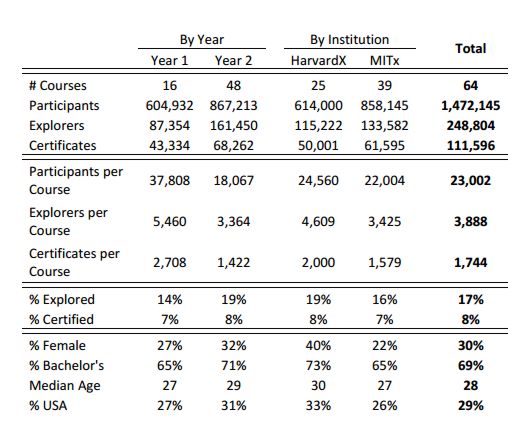| Massive Study On MOOCs |
| Written by Sue Gee | |||||||||||||||||||||||||||||||||||||||||||||
| Monday, 06 April 2015 | |||||||||||||||||||||||||||||||||||||||||||||
|
Researchers and Harvard and MIT have produced statistics about the first two years of the edX platform including its Computer Science courses.
A massive amount of effort has gone into courses on the edX platform, which is arguably the most polished and consistent of those that we regularly cover. Launched in 2012, edX set out to provide a richer learning experience for on-campus students at MIT, Harvard and its other partner students as well as provide online access to their courses around the world. From the outset there was a commitment to conduct research into how students learn, with Harvard President Drew Faust stating: “edX gives Harvard and MIT an unprecedented opportunity to dramatically extend our collective reach by conducting groundbreaking research into effective education and by extending online access to quality higher education.” The research to date has been directed at discovering whether MOOCs are living up to their promise of representing a disruptive force capable of widening the reach of university level education or, as their critics would have it, a dismal failure due to low completion rates. This investigation, from a team led by Andrew Dean Ho of Harvard and Isaac Chuang of MIT, expands on this by exploring: "how diverse audiences — including explorers, teachers-as-learners, and residential students — provide opportunities to advance the principles on which HarvardX and MITx were founded: access, research, and residential education." The survey covers data from two years and 68 open online courses offered on edX with a total of 1.03 million unique participants accounting for 1.71 million course entries. A participant is defined as: "Any registrant that has accessed course content in any chapter." This rules out those people who register for a course but then fail to access any content which excluded 1.3 million registrations from the analysis. An Explorer is defined as a participant who looked into more than half the chapters in a course. The report focuses on 1.47 million course participants from 64 certificate-granting courses making comparisons between HarvardX and MITx and between the first and second years.
Overall the proportion of particpants successfully completing a MOOC and gaining a certificate was just 8%. Are low completion rates something to be worried about? Probably not. When a course is offered free then there is no barrier to dipping into it to discover its suitability. The fact that over half of those who looked at over half the course content went on to gain a certificate by achieving a satisfactory score problem sets, quizzes and exams seems more important than the fact that a large proportion dropped out at an early stage. One interesting finding from the pre-course survey that was completed by around a third of participants was that of 57% who stated that their intent was to earn a certificate, 24% did earn certificates. Among the remaining 43% who were unsure or did not intend to earn a certificate, 8% ultimately did earn certificates. Of students who paid for an ID-verified certificate (on 12 courses that offered them) 59% went on to be certified compared to 5% for non-verified students. The table indicates that a high proportion of MOOC participants are already well qualified, with 69% already possessing a Bachelor's degree, that the median age is 28 and that 31% are female. However, in the case of Computer Science the proportion was only 17% are female. The Appendix to the report has statistics on individual courses and this permits a more in-depth look at the MITx Introduction to Computer Science and Programming. It began as a 16-week course, 6.00x which had two presentations and was then split into two 9-week courses, 6.001x and 6.002x. For the more advanced course the percentage of female participants fell while the proportion of those with a Bachelors or higher increased, as did median age.
The proportion of those who explored the course increased once it was split into two, as did the proportion of explorers who subsequently certified. These were highest for the second-level course. Although the completion rate expressed as the percentage of those who started these Python related courses is only 8%, almost 20,000 course certificates were issued to successful students during their initial two years and many more will follow. edX recently started offering free course authored by Microsoft and has also partnered with W3C to produce a course on HTML5. These may prove to be even more popular than its academic courses and have a disruptive impact on traditional methods of acquiring programming skills.
More Information HarvardX and MITx: Two Years of Open Online Courses Fall 2012-Summer 2014 (March 30, 2015). Available at SSRN: Related ArticlesHarvard and MIT Join Forces in edX
To be informed about new articles on I Programmer, install the I Programmer Toolbar, subscribe to the RSS feed, follow us on, Twitter, Facebook, Google+ or Linkedin, or sign up for our weekly newsletter.
Comments
or email your comment to: comments@i-programmer.info |
|||||||||||||||||||||||||||||||||||||||||||||
| Last Updated ( Tuesday, 07 April 2015 ) |




